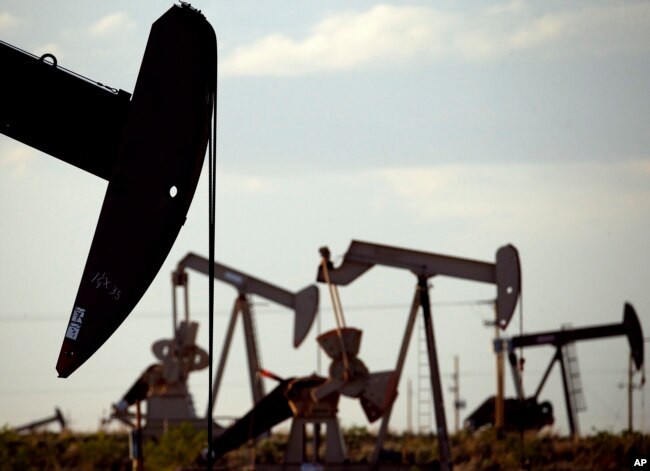企業や人間による化石燃料の使用、人間活動による農業からの自然排出、天然ガスを引き出す方法である水圧破砕、自然界の植物性物質の腐敗、温暖化が招くラニーニャ現象によるさらなる湿地帯からの放出などなど。加えて今後の現在凍結している北極圏の土地融解による上昇。
とどのつまり、暑さ寒さに耐え、肉食をなくし、徒歩圏内で生活し、すべての便利さを排除した先に、豊かな明るい世界がやってくる!!ということなのでしょう。さもなくば、メタンガス・二酸化炭素を 吸い取ってくれる機械を開発する!!
VOAで楽しく今日も英語を学びましょう!!
米国の研究者:メタンガス濃度が記録的な速さで上昇
US Researchers: Methane Levels Increase at Record Speed
April 13, 2022
メタンは、二酸化炭素よりも多くの熱を地球の大気中に閉じ込める天然ガスです。農耕動物、特に牛と、湿った場所にある植物質の腐敗が、最も多くのメタンを発生させます。
先週、アメリカ政府の研究者は、大気中のメタン濃度が過去最高量に増加したと発表しました。米国海洋大気庁(NOAA)の報告書では、破られた記録は一昨年に更新されたばかりであると指摘しています。
科学者たちはメタンを10億分の1(ppb)という単位で測定しています。
世界の先進国が約170年前に大規模な工場を建設する以前は、大気中のメタン濃度は10億分の720でした。今は、その2倍以上になっています。
2020年、メタンは前年比で15.3ppbと過去最高を記録しました。その1年後には17ppb上昇し、1895.7ppbに達しました。
科学者によると、メタンの放出、つまり排出は気候変動に大きく影響し、二酸化炭素の25倍もの熱を大気中に閉じ込めるそうです。
コーネル大学のロバート・ハワース教授はメタンの研究をしています。彼は、この報告書の発見を”極めて憂慮すべきもの”と呼んでいます。
国連の気候変動に関する政府間パネル、IPCC、は、1800年代以降の気温上昇に、メタンが約2分の1度寄与していると発表しています。
メタンと二酸化炭素の主な違いは、それらがどれくらい持続するかということです。二酸化炭素は数千年残るのに対し、メタンは9年程度で消えてしまいます。
そのため、多くの国が地球温暖化を速やかに遅らせる方法として、メタンの排出を減らそうとしています。目標は、今世紀末までに世界の気温が1.5〜2度以上上昇するのを防ぐことです。
ジーク・ハウスファーザー氏は、バークレー・アースという気候科学の会社の研究者です。彼は過去2年間のデータを懸念しています。
「メタンの排出を劇的に減らす必要があるのに、今日は明らかに間違った方向に進んでいます。」と彼は言います。しかしながら、メタンを削減すれば、"すぐに気候を冷やすことができる "と彼は言います。
リンジー・ラン氏は、NOAAとコロラド大学で働く大気科学者です。ラン氏は、メタンの増加の原因は人間の活動だけではないと言います。太平洋の温度を変化させるラニーニャと呼ばれる気象条件とも関係があるというのです。ラニーニャ現象によって雨が多くなり、通常より雨の多い地域からメタンが放出されているのです。
科学者たちは、凍結した北極圏の土地が暖かくなるにつれて、将来的にメタンが増加することも懸念しています。
ラン氏によれば、最近の増加はCOVID-19とそれが人間活動にもたらした変化と関係があるのではないかと考える科学者もいると言いますが、彼女の研究によれば、パンデミックの影響はほとんどなかったということです。
ハワース氏によれば、メタンの増加には化石燃料と農業の両方が重要であるとのことです。しかし、彼は、「私の研究は、2008年以降の増加の最大の原因は化石燃料であることを強く指摘している... 」と言っています。そして、ハワース氏は、地球から天然ガスを引き出す方法である水圧破砕が、増加の大部分を占めていると非難しています。
NOAAは、大気中のメタンの約30%は企業や人間による化石燃料の使用に由来すると指摘します。この部分は最も簡単に減らすことができる部分なのです。
ラン氏は2006年以降に増加したメタンの化学的構成について調査を行い、ほとんどが植物性物質の腐敗や農業からの自然排出によるものであると述べています。
メタンに関するニュースに加え、NOAAによると、二酸化炭素のレベルは、海が約23メートル高く、平均気温が約3.9度高かった450万年前とほぼ同じだと述べています。現在凍結している北極圏の一部には大きな森林がありました。
NOAAのリック・スピンラッド主任は声明で "排出は急速なペースで間違った方向に進み続けている "と述べています。
US Researchers: Methane Levels Increase at Record Speed
Methane is a natural gas that traps more heat in Earth’s atmosphere than carbon dioxide. Farm animals, especially cows, and the decay of plant matter in wet areas, create the most methane.
Last week, American government researchers announced that methane levels in the atmosphere had increased by a record amount. The report from the National Oceanic and Atmospheric Administration (NOAA) noted that the record broken had been set only the year before.
Scientists measure methane in parts per billion, or ppb.
Before the world’s developed nations started building large factories about 170 years ago, the methane level in the atmosphere was 720 parts per billion. Now, it is more than double that amount.
In 2020, methane went up by a record 15.3 ppb compared to the year before. One year later, it rose 17 ppb to reach 1895.7 ppb.
Scientists say methane releases, or emissions, affect climate change substantially, trapping 25 times more heat in the atmosphere than carbon dioxide.
Robert Howarth studies methane at Cornell University. He called the report’s findings “extremely disturbing.”
The United Nations’ Intergovernmental Panel on Climate Change, or IPCC, said methane has contributed to about a one-half degree Celsius rise in temperature since the 1800s.
The main difference between methane and carbon dioxide is how long they last. Carbon dioxide can remain for thousands of years while methane disappears in about nine years.
As a result, many nations are trying to reduce methane emissions as a way to quickly slow the planet’s warming. The goal is to prevent the world’s temperature from rising more than 1.5 to 2 degrees Celsius by the end of this century.
Zeke Hausfather is a researcher for a climate science company called Berkeley Earth. He is concerned about the data from the last two years.
“We need to cut our methane emissions dramatically, and today we are clearly moving in the wrong direction,” he said. However, he said cutting methane would “quickly cool the climate.”
Lindsay Lan is an atmospheric scientist who works with NOAA and the University of Colorado. Lan said human activity is not the only reason for the rise in methane. She said it is also connected to the weather condition called La Nina, which changes the temperature of the Pacific Ocean. La Nina causes more rainfall, and some of the methane release has come from areas that are wetter than normal.
Scientists are also concerned about future methane increases as frozen Arctic land warms.
Lan said some scientists believed the recent increases may have been linked to COVID-19 and the changes it brought to human activities. But, her research suggests the pandemic had little effect.
Howarth said both fossil fuels and agriculture are critical to methane increases. But he said, “my research strongly points toward fossil fuels as being the largest cause of the increase since 2008….” And, Howarth blamed hydraulic fracturing, a method of pulling natural gas from the Earth, for much of the increase.
NOAA notes that about 30 percent of the methane in the atmosphere comes from businesses and human use of fossil fuels. That is the part that can most easily be reduced.
Lan did a study of the chemical makeup of the methane increases since 2006 and said most comes from natural emissions from plant material decaying or from agriculture.
In addition to the news about methane, NOAA said carbon dioxide levels are now about the same as they were 4.5 million years ago when seas were about 23 meters higher and the average temperature was warmer by about 3.9 degrees Celsius. Parts of the Arctic that are now frozen had large forests.
In a statement, NOAA’s chief, Rick Spinrad, said “emissions continue to move in the wrong direction at a rapid pace.”
Words in This Story
disturb –v. to worry or upset someone
dramatically – adv. suddenly or extremely
fossil fuel – n. fuel that is formed in the earth from dead plants or animals
decay – v. to be slowly destroyed by natural processes, broken down
rapid – adj. happening quickly or in a short amount of time
pace – n. the speed at which something moves

